1. Statistics Korea. 2010 the Aged Statistics. Daejeon: Statistics Korea;2010. p. 1–36.
2. Ezeh AC, Bongaarts J, Mberu B. Global population trends and policy options. Lancet. 2012; 380:142–148. PMID:
22784532.

3. Han P, Suarez-Durall P, Mulligan R. Dry mouth: a critical topic for older adult patients. J Prosthodont Res. 2015; 59:6–19. PMID:
25498205.

4. Ikebe K, Matsuda K, Morii K, Wada M, Hazeyama T, Nokubi T, Ettinger RL. Impact of dry mouth and hyposalivation on oral health-related quality of life of elderly Japanese. Oral Surg Oral Med Oral Pathol Oral Radiol Endod. 2007; 103:216–222. PMID:
17234539.

5. Gerdin EW, Einarson S, Jonsson M, Aronsson K, Johansson I. Impact of dry mouth conditions on oral health-related quality of life in older people. Gerodontology. 2005; 22:219–226. PMID:
16329230.

6. Plemons JM, Al-Hashimi I, Marek CL. American Dental Association Council on Scientific Affairs. Managing xerostomia and salivary gland hypofunction: executive summary of a report from the American Dental Association Council on Scientific Affairs. J Am Dent Assoc. 2014; 145:867–873. PMID:
25082939.
7. Rusthen S, Young A, Herlofson BB, Aqrawi LA, Rykke M, Hove LH, Palm Ø, Jensen JL, Singh PB. Oral disorders, saliva secretion, and oral health-related quality of life in patients with primary Sjögren's syndrome. Eur J Oral Sci. 2017; 125:265–271. PMID:
28643390.

8. Pajukoski H, Meurman JH, Halonen P, Sulkava R. Prevalence of subjective dry mouth and burning mouth in hospitalized elderly patients and outpatients in relation to saliva, medication, and systemic diseases. Oral Surg Oral Med Oral Pathol Oral Radiol Endod. 2001; 92:641–649. PMID:
11740482.

9. Gupta A, Epstein JB, Sroussi H. Hyposalivation in elderly patients. J Can Dent Assoc. 2006; 72:841–846. PMID:
17109806.
10. Iwasaki M, Yoshihara A, Ito K, Sato M, Minagawa K, Muramatsu K, Watanabe R, Manz MC, Ansai T, Miyazaki H. Hyposalivation and dietary nutrient intake among community-based older Japanese. Geriatr Gerontol Int. 2016; 16:500–507. PMID:
25952943.

11. Orellana MF, Lagravère MO, Boychuk DG, Major PW, Flores-Mir C, Ortho C. Prevalence of xerostomia in population-based samples: a systematic review. J Public Health Dent. 2006; 66:152–158. PMID:
16711637.

12. Samaranayake LP, Wilkieson CA, Lamey PJ, MacFarlane TW. Oral disease in the elderly in long-term hospital care. Oral Dis. 1995; 1:147–151. PMID:
8705820.

13. Ohara Y, Hirano H, Yoshida H, Obuchi S, Ihara K, Fujiwara Y, Mataki S. Prevalence and factors associated with xerostomia and hyposalivation among community-dwelling older people in Japan. Gerodontology. 2016; 33:20–27. PMID:
24304087.

14. Nederfors T. Xerostomia and hyposalivation. Adv Dent Res. 2000; 14:48–56. PMID:
11842923.

15. Thorselius I, Emilson CG, Osterberg T. Salivary conditions and drug consumption in older age groups of elderly Swedish individuals. Gerodontics. 1988; 4:66–70. PMID:
3209028.
16. Scully C. Drug effects on salivary glands: dry mouth. Oral Dis. 2003; 9:165–176. PMID:
12974516.
17. Terrie YC. Dry mouth: more common and less benign than thought. Pharm Times. 2016.
18. Mandl T, Ekberg O, Wollmer P, Manthorpe R, Jacobsson LT. Dysphagia and dysmotility of the pharynx and oesophagus in patients with primary Sjögren's syndrome. Scand J Rheumatol. 2007; 36:394–401. PMID:
17963171.

19. Tashbayev B, Rusthen S, Young A, Herlofson BB, Hove LH, Singh PB, Rykke M, Aqrawi LA, Chen X, Utheim OA, Utheim TP, Palm Ø, Jensen JL. Interdisciplinary, comprehensive oral and ocular evaluation of patients with primary Sjögren's syndrome. Sci Rep. 2017; 7:10761. PMID:
28883442.

20. Willett W. Issues in analysis and presentation of dietary data. In : Willett W, editor. Nutritional Epidemiology. 2nd ed. New York, NY: Oxford University Press;1998. p. 321–346.
21. Food and Agriculture Organization of the United Nations. Dietary Assessment: a Resource Guide to Method Selection and Application in Low Resource Settings. Rome: Food and Agriculture Organization of the United Nations;2018.
22. Korean Nutrition Society. CAN-Pro 5.0 (Web ver.): Computer Aided Nutritional Analysis Program. Seoul: Korean Nutrition Society;2015.
23. Slade GD. Derivation and validation of a short-form oral health impact profile. Community Dent Oral Epidemiol. 1997; 25:284–290. PMID:
9332805.

24. Lee SY. Development of questionnaire for evaluation of dry mouth treatments [master's thesis]. Seoul: Seoul National University;2015.
25. Fox PC, Busch KA, Baum BJ. Subjective reports of xerostomia and objective measures of salivary gland performance. J Am Dent Assoc. 1987; 115:581–584. PMID:
3477595.

26. Kim BI, Jeong SH, Chung KH, Cho YK, Kwon HK, Choi CH. Subjective food intake ability in relation to maximal bite force among Korean adults. J Oral Rehabil. 2009; 36:168–175. PMID:
19054290.

27. Ichikawa K, Sakuma S, Yoshihara A, Miyazaki H, Funayama S, Ito K, Igarashi A. Relationships between the amount of saliva and medications in elderly individuals. Gerodontology. 2011; 28:116–120. PMID:
20545772.

28. Smidt D, Torpet LA, Nauntofte B, Heegaard KM, Pedersen AM. Associations between labial and whole salivary flow rates, systemic diseases and medications in a sample of older people. Community Dent Oral Epidemiol. 2010; 38:422–435. PMID:
20545715.

29. Park MS, Ryu SA. Degree of dry mouth and factors influencing oral health-related quality of life for community-dwelling elders. J Korean Acad Nurs. 2010; 40:747–755. PMID:
21157176.

30. Johanson CN, Österberg T, Lernfelt B, Ekström J, Birkhed D. Salivary secretion and drug treatment in four 70-year-old Swedish cohorts during a period of 30 years. Gerodontology. 2015; 32:202–210. PMID:
26288310.
31. Cassolato SF, Turnbull RS. Xerostomia: clinical aspects and treatment. Gerodontology. 2003; 20:64–77. PMID:
14697016.

32. Lee KW, Shin D, Song WO. Total water intake from beverages and foods is associated with energy intake and eating behaviors in Korean adults. Nutrients. 2016; 8:E617. PMID:
27782040.

33. Åstrøm AN, Lie SA, Ekback G, Gülcan F, Ordell S. Self-reported dry mouth among ageing people: a longitudinal, cross-national study. Eur J Oral Sci. 2019; 127:130–138. PMID:
30584805.

34. Locker D. Dental status, xerostomia and the oral health-related quality of life of an elderly institutionalized population. Spec Care Dentist. 2003; 23:86–93. PMID:
14650556.

35. Lee JH. Dry mouth in the Korean elderly: associate factors, and impacts on oral health related quality of life [master's thesis]. Seoul: Seoul National University;2006.
36. Fox PC, van der Ven PF, Sonies BC, Weiffenbach JM, Baum BJ. Xerostomia: evaluation of a symptom with increasing significance. J Am Dent Assoc. 1985; 110:519–525. PMID:
3858368.

37. Villa A, Polimeni A, Strohmenger L, Cicciù D, Gherlone E, Abati S. Dental patients' self-reports of xerostomia and associated risk factors. J Am Dent Assoc. 2011; 142:811–816. PMID:
21719803.

38. Won YS, Kim JH, Kim SK. Relationship of subjective oral health status to subjective oral symptoms for the elderly in some Seoul area. J Dent Hyg Sci. 2009; 9:375–380.
39. Steele JG, Sanders AE, Slade GD, Allen PF, Lahti S, Nuttall N, Spencer AJ. How do age and tooth loss affect oral health impacts and quality of life? A study comparing two national samples. Community Dent Oral Epidemiol. 2004; 32:107–114. PMID:
15061859.

40. Pai S, Ghezzi EM, Ship JA. Development of a Visual Analogue Scale questionnaire for subjective assessment of salivary dysfunction. Oral Surg Oral Med Oral Pathol Oral Radiol Endod. 2001; 91:311–316. PMID:
11250628.

41. Leslie W, Hankey C. Aging, nutritional status and health. Healthcare (Basel). 2015; 3:648–658. PMID:
27417787.

42. Rodrigues HL Jr, Scelza MF, Boaventura GT, Custódio SM, Moreira EA, Oliveira DL. Relation between oral health and nutritional condition in the elderly. J Appl Oral Sci. 2012; 20:38–44. PMID:
22437676.
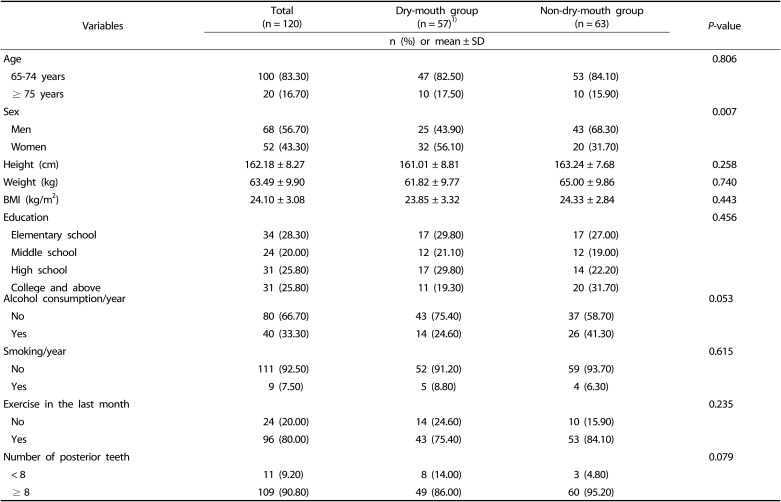

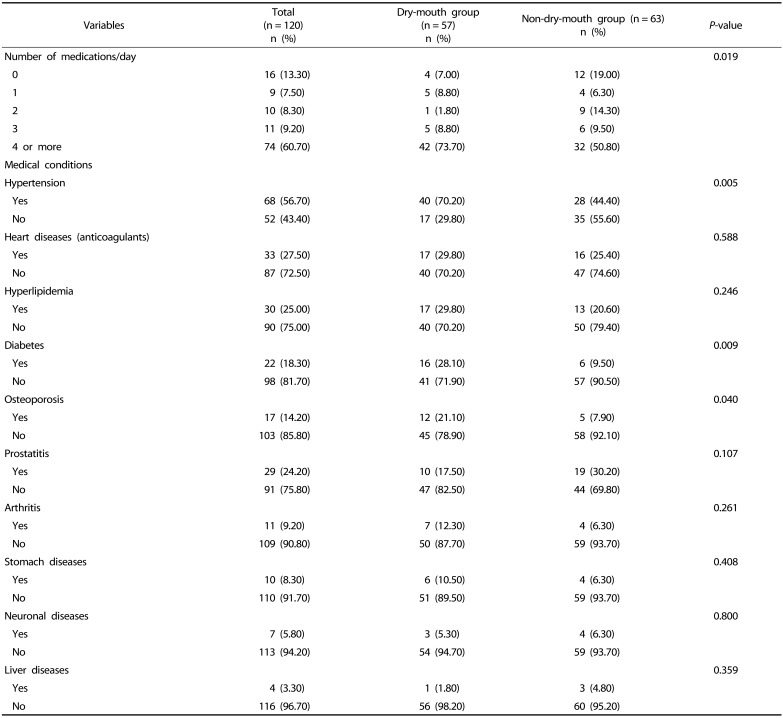
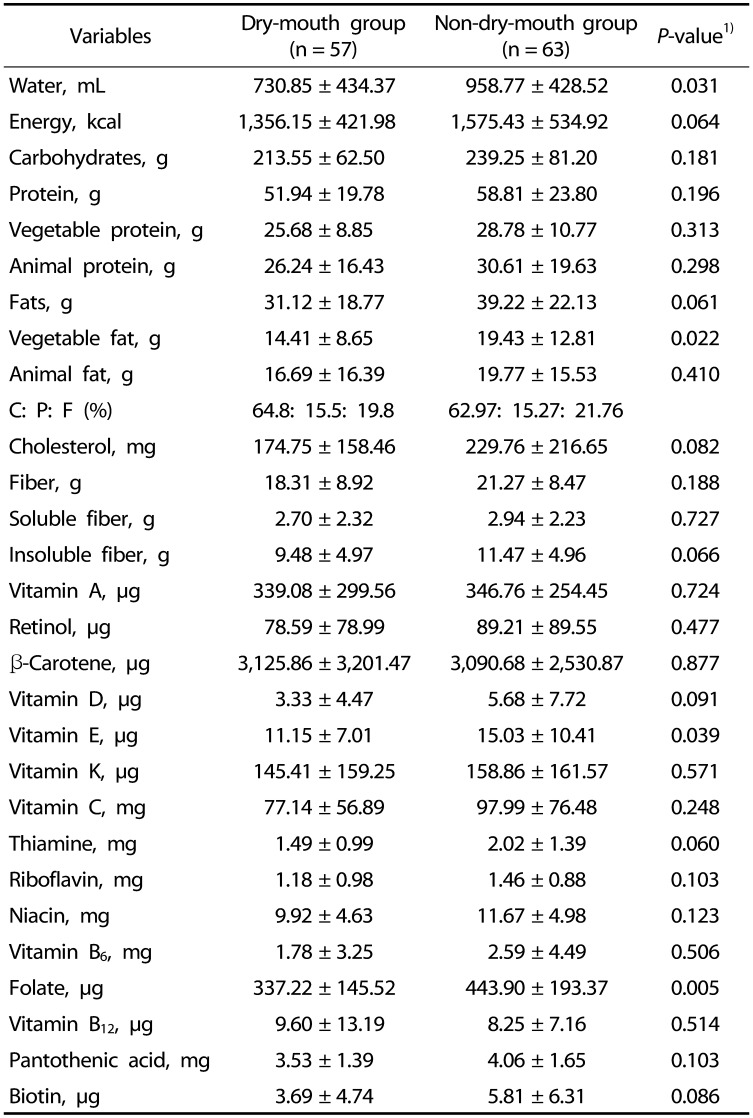
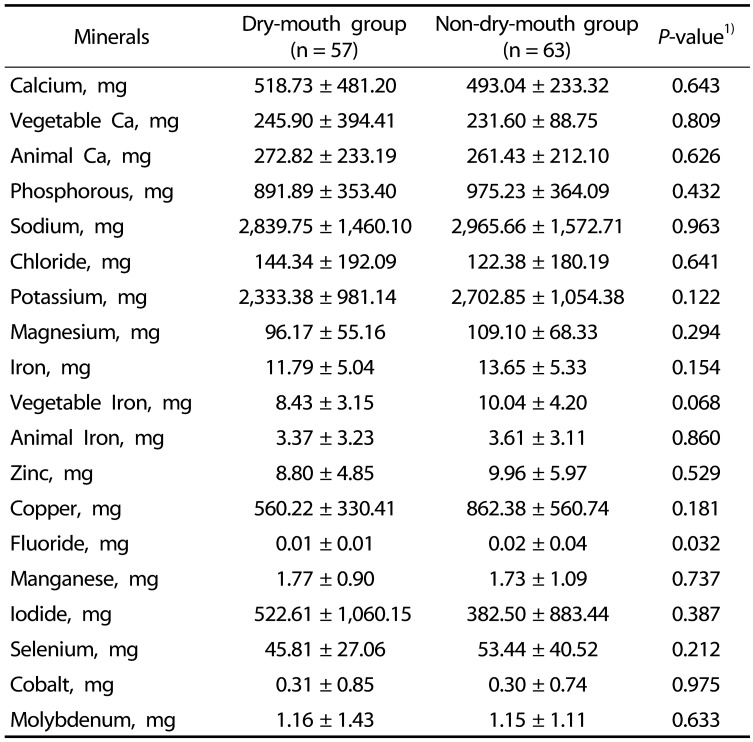
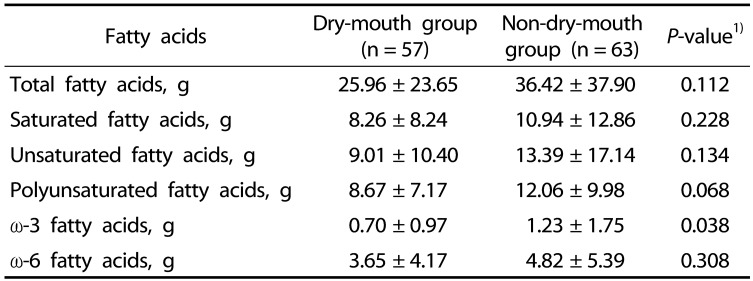
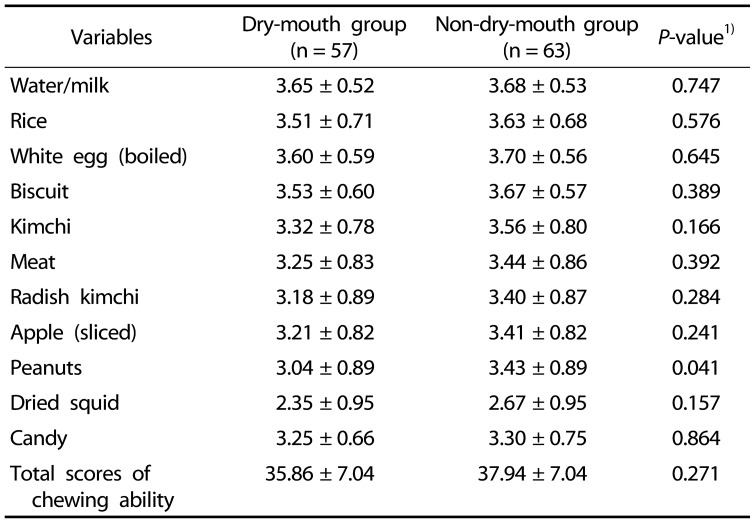
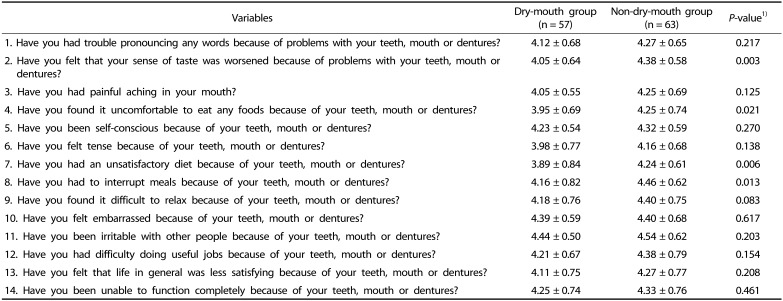




 PDF
PDF ePub
ePub Citation
Citation Print
Print



 XML Download
XML Download